“The Song of the Earth”
Hamburg Ballet – John Neumeier
Hamburg State Opera
Hamburg, Germany
December 09, 2016
by Ilona Landgraf
Copyright © 2016 by Ilona Landgraf
 While the Nutcracker-season is in full swing elsewhere, some ballet stages in German-speaking countries bring up serious and even fierce topics during Christmas time. Just recently, Christian Spuck premiered “Messa da Requiem”, his new creation for Zurich Ballet; the Bavarian State Ballet is in its final rehearsals for “Spartacus” awaiting Yuri Grigorovich’s finishing touch. In Hamburg, John Neumeier added another ballet, his fifteenth, to his encyclopedic collection of choreographies to music by Gustav Mahler. This time he chose Mahler’s symphonic song cycle “The Song of the Earth”, composed in 1908/09. Actually Neumeier’s ballet of the same title already
While the Nutcracker-season is in full swing elsewhere, some ballet stages in German-speaking countries bring up serious and even fierce topics during Christmas time. Just recently, Christian Spuck premiered “Messa da Requiem”, his new creation for Zurich Ballet; the Bavarian State Ballet is in its final rehearsals for “Spartacus” awaiting Yuri Grigorovich’s finishing touch. In Hamburg, John Neumeier added another ballet, his fifteenth, to his encyclopedic collection of choreographies to music by Gustav Mahler. This time he chose Mahler’s symphonic song cycle “The Song of the Earth”, composed in 1908/09. Actually Neumeier’s ballet of the same title already 
 received its premiere in early 2015 with Paris Opera Ballet. This December’s premiere with Neumeier’s own company in Hamburg is said to present the revised and deepened second version, but, since I missed the Paris original, I can’t estimate the extent of alterations.
received its premiere in early 2015 with Paris Opera Ballet. This December’s premiere with Neumeier’s own company in Hamburg is said to present the revised and deepened second version, but, since I missed the Paris original, I can’t estimate the extent of alterations.
Having choreographed for almost half a century, Neumeier cannot be expected to radically change his style. Once innovative 
 and a blessed storyteller the spectrum within which he has worked for a great many years is set. This problem shows up all the more as the input of the dancers into the choreographic process has become limited. Asked about the evolution generating “The Song of the Earth”, Neumeier states in the program booklet, that solely his own intuition determined the creation and
and a blessed storyteller the spectrum within which he has worked for a great many years is set. This problem shows up all the more as the input of the dancers into the choreographic process has become limited. Asked about the evolution generating “The Song of the Earth”, Neumeier states in the program booklet, that solely his own intuition determined the creation and 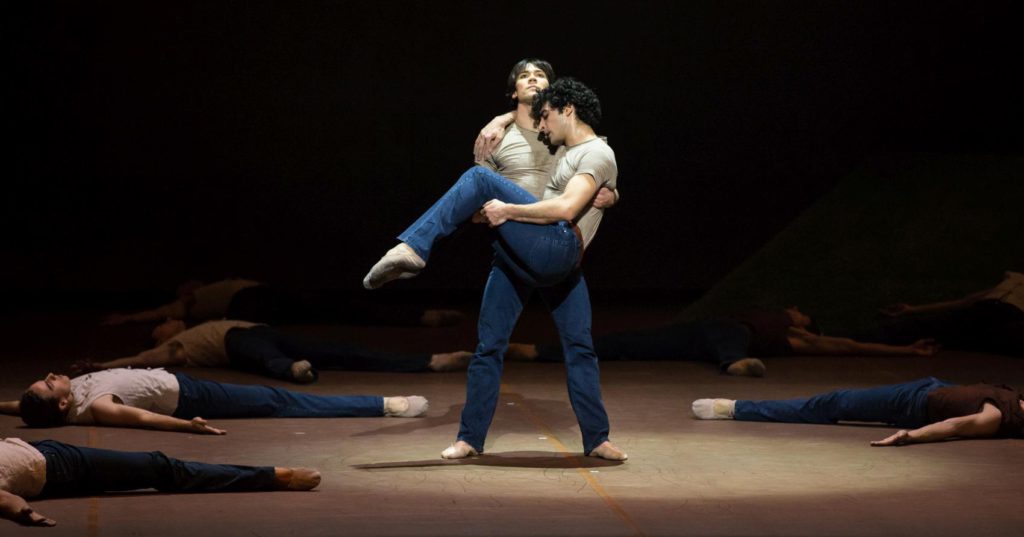 that via improvisation he transferred his emotions onto the dancers. That testifies, after all, that he has a profound ego.
that via improvisation he transferred his emotions onto the dancers. That testifies, after all, that he has a profound ego.
A doyen of his art form, Neumeier isn’t shy, either, to deem himself called upon for perfecting others’ pieces of art. In “Hamlet”, for example, he believes he is giving expression to what Shakespeare actually intended to say. In terms of Mahler’s “The Song of the Earth”, Neumeier declares he has carried the composition’s poetic thread forward and has further developed aspects of the eternal existence of the world and the mortality of human beings. Well, where to?
 The whole production is guided by Neumeier: choreography, stage design, costumes, lighting. Unquestionably, he has taste and has again proved himself the master of the perfect look. The only prop next to a few white tea cups and tea bowls is a slanted platform similar to the ones we know from his “Messiah” and “Purgatorio”, choreography to Mahler’s tenth symphony. As in “Purgatorio” lush green grass covers the platform. The dancers either sit, doze, stand, do a headstand, slide or roll down the
The whole production is guided by Neumeier: choreography, stage design, costumes, lighting. Unquestionably, he has taste and has again proved himself the master of the perfect look. The only prop next to a few white tea cups and tea bowls is a slanted platform similar to the ones we know from his “Messiah” and “Purgatorio”, choreography to Mahler’s tenth symphony. As in “Purgatorio” lush green grass covers the platform. The dancers either sit, doze, stand, do a headstand, slide or roll down the  green. A huge full moon shines on the backdrop above the platform. Its color oscillates from dark blue to golden, red and so on, nicely contrasted by the finely tuned changes of colors of its edge. Well-matching light reflections complement the lunar orb’s sophisticated design. Actually, this moon is so perfectly styled that watching it was sometimes more captivating than watching the dancers.
green. A huge full moon shines on the backdrop above the platform. Its color oscillates from dark blue to golden, red and so on, nicely contrasted by the finely tuned changes of colors of its edge. Well-matching light reflections complement the lunar orb’s sophisticated design. Actually, this moon is so perfectly styled that watching it was sometimes more captivating than watching the dancers.

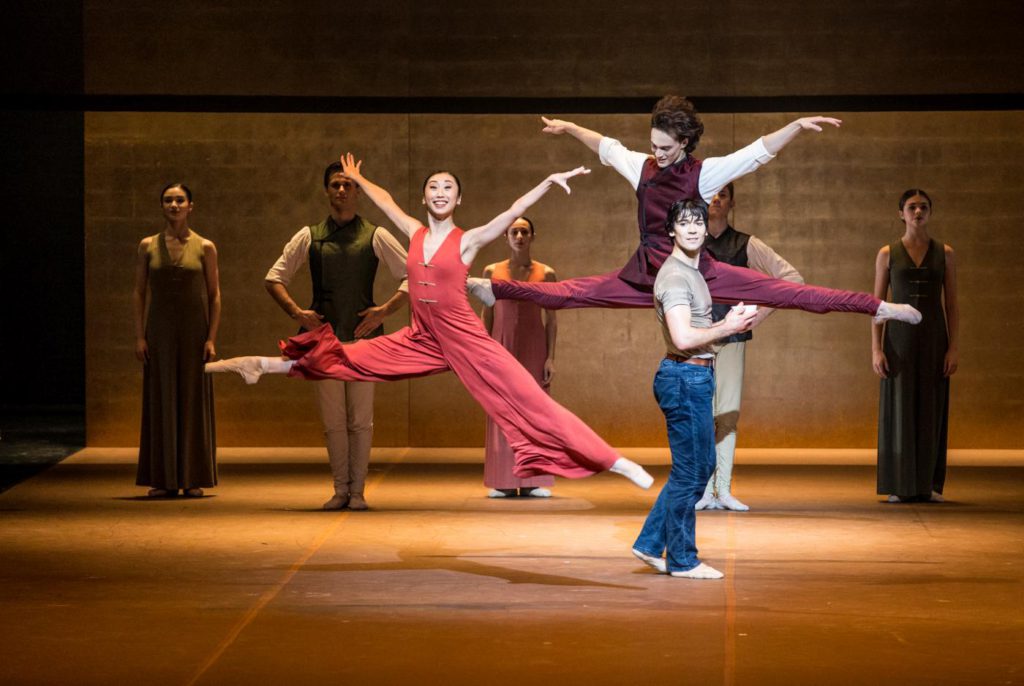 The remaining set design is discreet: a semi-transparent black curtain in the background, wafts of mist high above and special lighting, which sometimes surrounds the dancers with an aura of golden light, create a subtle differentiation between the real world and some intermediate realm. The backdrop has the faint structure of a brick wall similar to the one Neumeier used in
The remaining set design is discreet: a semi-transparent black curtain in the background, wafts of mist high above and special lighting, which sometimes surrounds the dancers with an aura of golden light, create a subtle differentiation between the real world and some intermediate realm. The backdrop has the faint structure of a brick wall similar to the one Neumeier used in 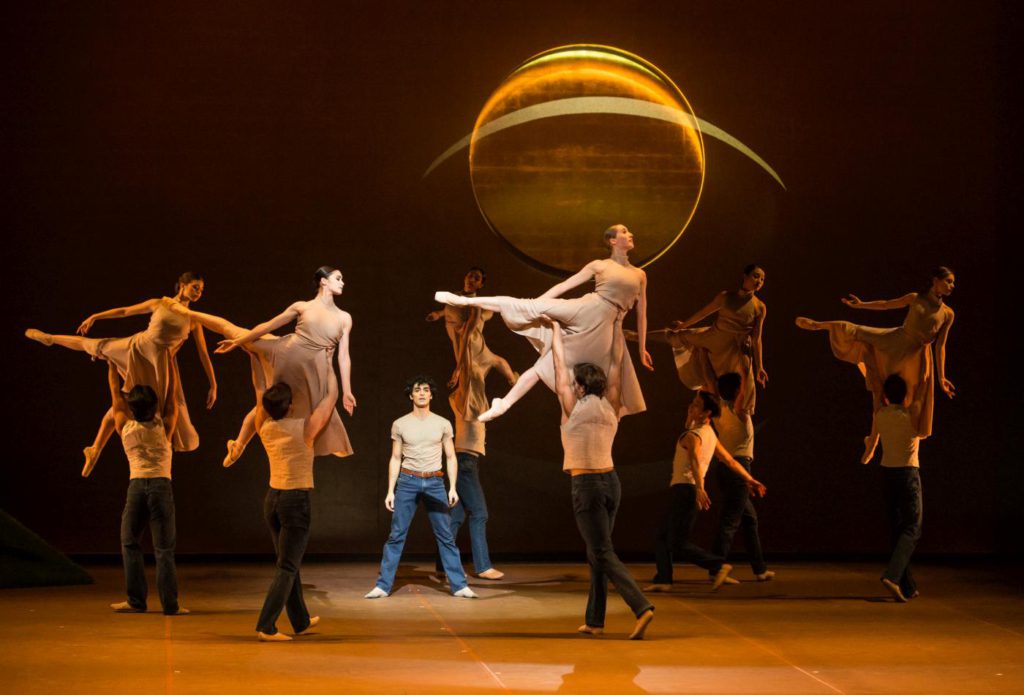 “Verklungene Feste”. The tilted mirror hanging high above on the ceiling is nothing new either. A similar one hung above the scenery of “Messiah”.
“Verklungene Feste”. The tilted mirror hanging high above on the ceiling is nothing new either. A similar one hung above the scenery of “Messiah”.
There is a feeling of déjà vu also in terms of the costumes. The women’s monochrome calf-length dresses, skirts / tops and pantsuits recall the plain chic of a collaborator of Neumeier on former occasions: Albert Kriemler, haute couture designer of AKRIS. But putting the men in jeans and polo shirts for sure is genuinely by Neumeier. Watching two main figures of “The Song of the Earth”, Alexandr Trusch and Karen Azatyan, in this attire, I thought of another pair in one of Neumeier’s ballets, the two men in “Death in Venice”, metamorphosing from wanderers to gondoliers, hairdressers, guitar players, Dionysus and dance couple. Let’s assume all those cross-references 
 are intended and not a recycling of old ideas.
are intended and not a recycling of old ideas.
Mahler composed “The Song of the Earth” after having gone through a highly painful period in his life. Its six songs, sung by Klaus Florian Vogt (tenor) and Michael Kupfer-Radecky (baritone) and sensitively played by Hamburg’s Philharmonic State Orchestra under the baton of Simon Hewett, are based on seven poems of “The Chinese Flute”, a volume of ancient Chinese poetry rendered into the German by Hans Bethge. The verses, dealing with earthly beauty and transience, are suffused with melancholy and grief.

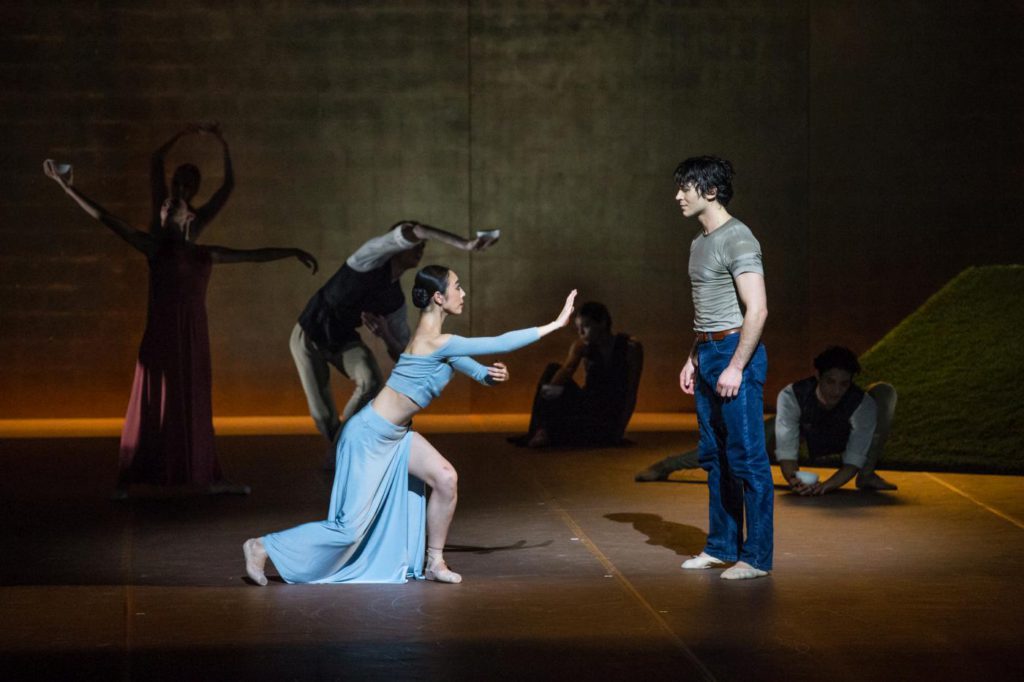 Mahler’s composition has a running time of around one hour. To grow into a full-evening ballet the song cycle needed extension. Longer moments of silence between the songs and an additional prelude helped to extend the ballet to ninety minutes without break. Assembled of fragments of the piano reduction of the sixth song, “The Farewell”, interspersed with silence, this prelude moreover draws a bow to the end of the piece.
Mahler’s composition has a running time of around one hour. To grow into a full-evening ballet the song cycle needed extension. Longer moments of silence between the songs and an additional prelude helped to extend the ballet to ninety minutes without break. Assembled of fragments of the piano reduction of the sixth song, “The Farewell”, interspersed with silence, this prelude moreover draws a bow to the end of the piece.
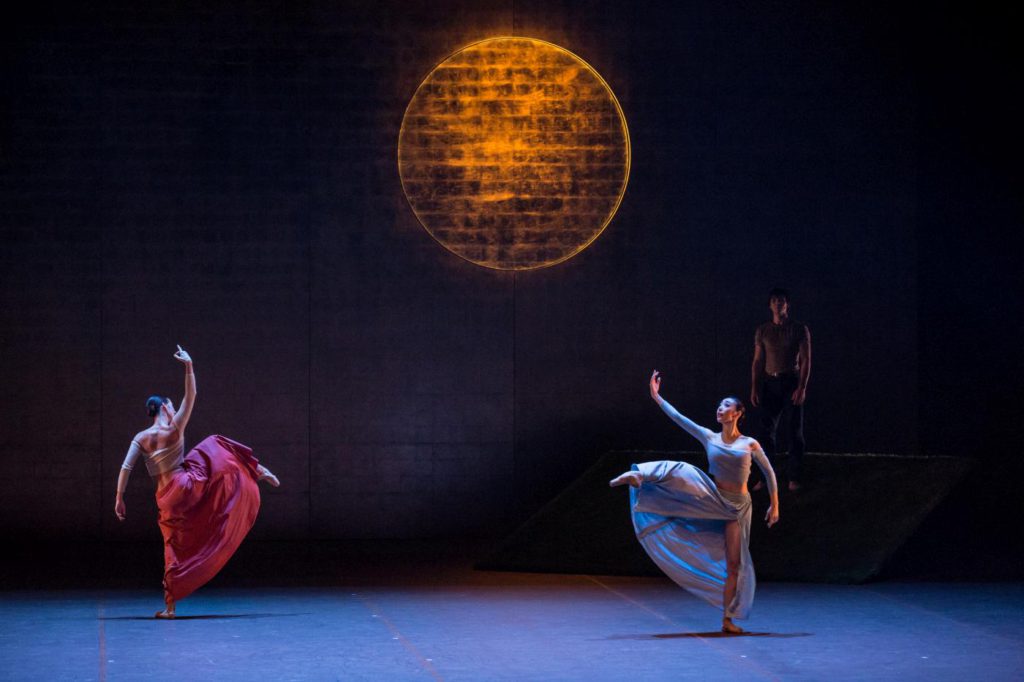
 Neumeier responded to each song’s atmosphere and subject with a mix of solos, pas de deux and group dances. His use of space is brilliant, the distribution of dancers utmost decorative. Light effects, colors, atmosphere – everything fits together perfectly. One only needs to release the shutter to get beautiful shots for next year’s calender. If only the
Neumeier responded to each song’s atmosphere and subject with a mix of solos, pas de deux and group dances. His use of space is brilliant, the distribution of dancers utmost decorative. Light effects, colors, atmosphere – everything fits together perfectly. One only needs to release the shutter to get beautiful shots for next year’s calender. If only the 
 choreography, drawing on well-trodden vocabulary, wouldn’t be so lulling. We see familiar gestures, phrases, lifts and jumps, also references to the poems’ Asian origin – walking with shuffling mincing steps or a tea ceremony in the third song – which even in faster parts breathe sedate composure. The composition calls for contemplative calm but, to make the calm touching and meaningful, one needs expressive dancers with a strong stage presence. And here is the crux of the matter.
choreography, drawing on well-trodden vocabulary, wouldn’t be so lulling. We see familiar gestures, phrases, lifts and jumps, also references to the poems’ Asian origin – walking with shuffling mincing steps or a tea ceremony in the third song – which even in faster parts breathe sedate composure. The composition calls for contemplative calm but, to make the calm touching and meaningful, one needs expressive dancers with a strong stage presence. And here is the crux of the matter.

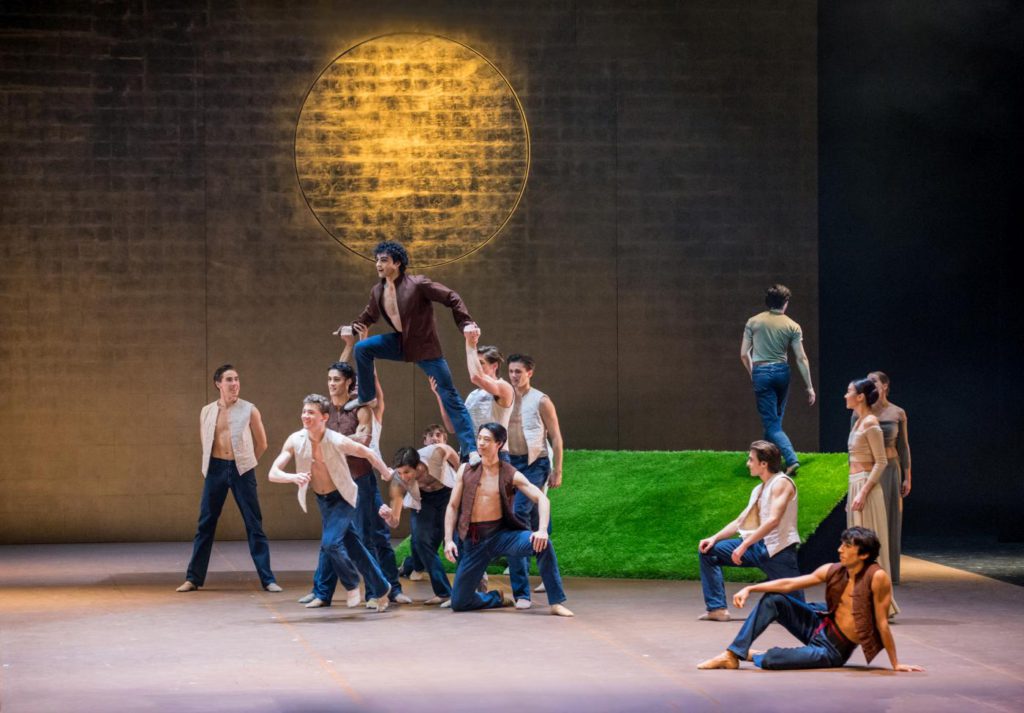 Except for one dancer, the whole ensemble performed flawlessly, but uninspiredly. This exception was short Aleix Martínez breaking through the evening’s tedious measuredness with genuine verve like an invigorating blow of fresh air in an overheated living room.
Except for one dancer, the whole ensemble performed flawlessly, but uninspiredly. This exception was short Aleix Martínez breaking through the evening’s tedious measuredness with genuine verve like an invigorating blow of fresh air in an overheated living room. 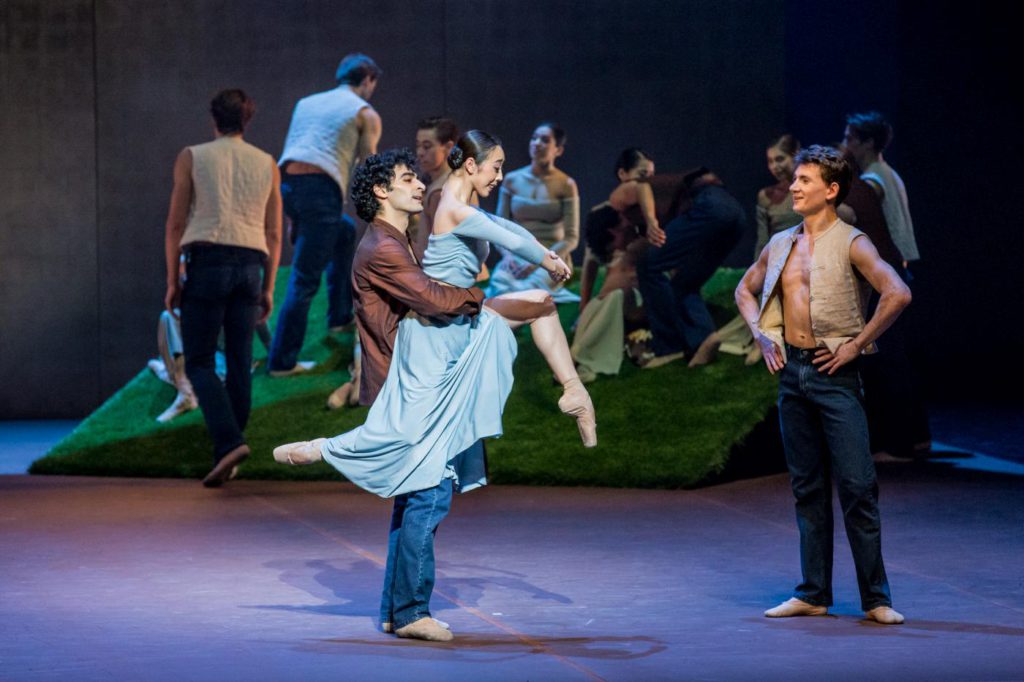 Martínez’s vitality even infected Azatyan, known as an expressive, touching dancer but beyond his abilities when teamed up with Trusch.
Martínez’s vitality even infected Azatyan, known as an expressive, touching dancer but beyond his abilities when teamed up with Trusch.
The first minutes of the prelude were entirely Hélène Bouchet’s. Clad in white she might have depicted a knowing spirit from the otherworld, a peaceful presence, protective mother or maybe the symbol of the continual renewal of life. Who knows? Bouchet also closed the sixth song when, lifted high in the air by Trusch, she was carried across the stage. But, once slender, Bouchet, a mature ballerina, has become more robust and, sadly, less subtle.
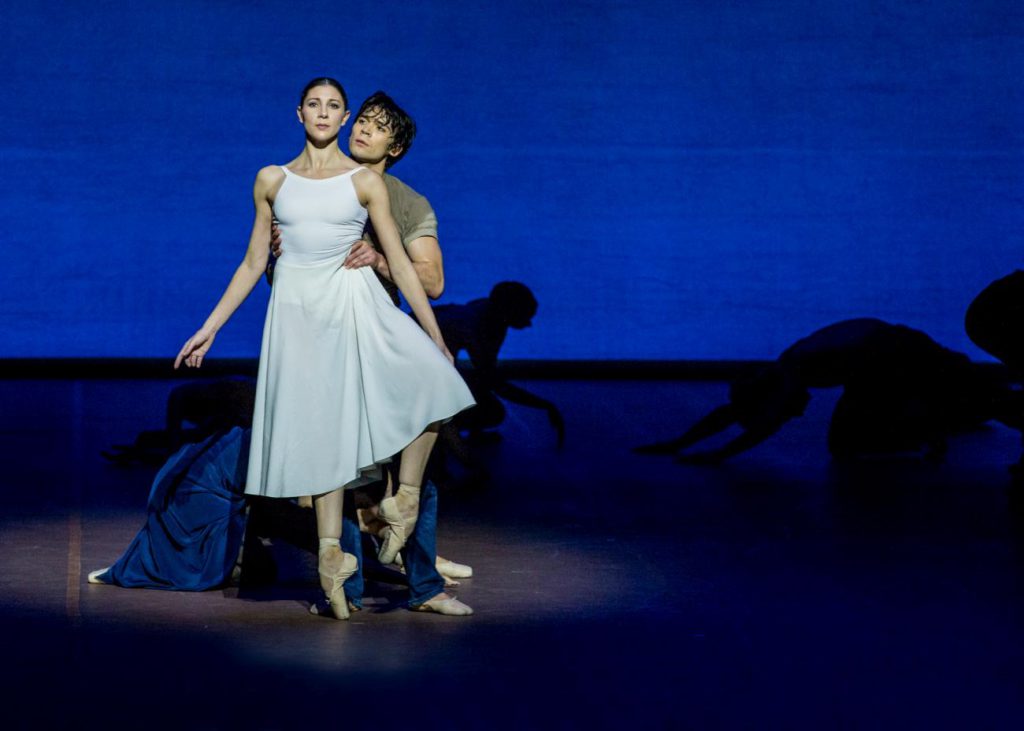
 Ten years ago one went home from Hamburg State Opera feeling enriched by Neumeier’s art. Those days are gone. I wonder how Hamburg Ballet intends to reinvigorate its significance as one of Germany’s leading companies during the next years.
Ten years ago one went home from Hamburg State Opera feeling enriched by Neumeier’s art. Those days are gone. I wonder how Hamburg Ballet intends to reinvigorate its significance as one of Germany’s leading companies during the next years.

| Links: | Website of Hamburg Ballet – John Neumeier | |
| Website of Silvano Ballone / Photographer | ||
| Photos: | 1. | Hélène Bouchet and Alexandr Trusch, “The Song of the Earth” by John Neumeier, Hamburg Ballet |
| 2. | Karen Azatyan and Alexandr Trusch, “The Song of the Earth” by John Neumeier, Hamburg Ballet | |
| 3. | Karen Azatyan, Alexandr Trusch and Hélène Bouchet, “The Song of the Earth” by John Neumeier, Hamburg Ballet | |
| 4. | Alexandr Trusch, “The Song of the Earth” by John Neumeier, Hamburg Ballet | |
| 5. | Alexandr Trusch, “The Song of the Earth” by John Neumeier, Hamburg Ballet | |
| 6. | Karen Azatyan, Alexandr Trusch and ensemble, “The Song of the Earth” by John Neumeier, Hamburg Ballet | |
| 7. | Alexandr Trusch and ensemble, “The Song of the Earth” by John Neumeier, Hamburg Ballet | |
| 8. | Mayo Arii, Alexandr Trusch and ensemble, “The Song of the Earth” by John Neumeier, Hamburg Ballet | |
| 9. | Mayo Arii, Jacopo Bellussi, Alexandr Trusch and ensemble, “The Song of the Earth” by John Neumeier, Hamburg Ballet | |
| 10. | Alexandr Trusch, Mayo Arii, Jacopo Bellussi and ensemble, “The Song of the Earth” by John Neumeier, Hamburg Ballet | |
| 11. | Karen Azatyan and ensemble, “The Song of the Earth” by John Neumeier, Hamburg Ballet | |
| 12. | Alexandr Trusch, Xue Lin and Karen Azatyan, “The Song of the Earth” by John Neumeier, Hamburg Ballet | |
| 13. | Alexandr Trusch, Hélène Bouchet, Leslie Heylmann and Xue Lin, “The Song of the Earth” by John Neumeier, Hamburg Ballet | |
| 14. | Xue Lin, Alexandr Trusch and ensemble, “The Song of the Earth” by John Neumeier, Hamburg Ballet | |
| 15. | Mayo Arii, Alexandr Trusch and Jacopo Bellussi, “The Song of the Earth” by John Neumeier, Hamburg Ballet | |
| 16. | Leslie Heylmann, Xue Lin and Alexandr Trusch, “The Song of the Earth” by John Neumeier, Hamburg Ballet | |
| 17. | Alexandr Trusch and ensemble, “The Song of the Earth” by John Neumeier, Hamburg Ballet | |
| 18. | Alexandr Trusch and ensemble, “The Song of the Earth” by John Neumeier, Hamburg Ballet | |
| 19. | Christopher Evans and ensemble, “The Song of the Earth” by John Neumeier, Hamburg Ballet | |
| 20. | Ensemble, “The Song of the Earth” by John Neumeier, Hamburg Ballet | |
| 21. | Ensemble, “The Song of the Earth” by John Neumeier, Hamburg Ballet | |
| 22. | Karen Azatyan, Xue Lin, Konstantin Tselikov and ensemble, “The Song of the Earth” by John Neumeier, Hamburg Ballet | |
| 23. | Hélène Bouchet, Alexandr Trusch and ensemble, “The Song of the Earth” by John Neumeier, Hamburg Ballet | |
| 24. | Hélène Bouchet, Alexandr Trusch and ensemble, “The Song of the Earth” by John Neumeier, Hamburg Ballet | |
| 25. | Alexandr Trusch and ensemble, “The Song of the Earth” by John Neumeier, Hamburg Ballet | |
| all photos © Silvano Ballone 2016 | ||
| Editing: | Agnes Farkas |



